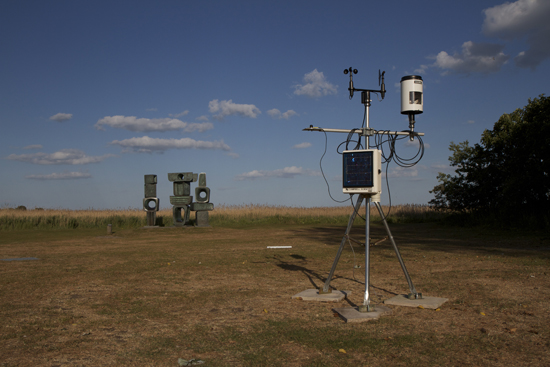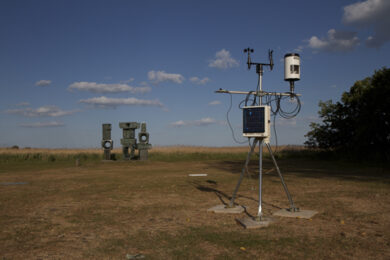A year ago, I went down to Dungeness and spent a day wandering around on the pebbles and sea grass of that remarkable foreshore. My visit was soundtracked not by iPod and headphones, but by Variable 4, a brilliant sound installation created by James Bulley and Daniel Jones of Goldsmiths. The installation, which can be seen in the image above, used the environment – wind speed, humidity, temperature etc – to trigger music, which was then played through speakers hidden in the foreshore. You can read my piece on Variable 4 in Dungeness for Caught By The River here. This weekend, Variable 4 will be re-installed at the Faster Than Sound Festival in Suffolk. Here, James and Daniel explain:
Since the earliest civilizations, a complex relationship has existed between human society and the weather systems that define the world around us. We make sense of seasonal cycles through rituals and folklore, passing down ways of harnessing the natural elements whilst constructing defences against those that threaten our existence.
Variable 4 transforms weather patterns into a living musical composition with the same unpredictability as the elements themselves. Using meteorological sensors connected to a custom software environment developed by the artists the wild weather conditions of Snape Maltings, Suffolk, act as both composer and conductor, navigating through a map of 24 movements inspired by the location.
Factors such as wind speed and humidity are translated into musical patterns: an incoming shower triggers a harp glissando; a buffeting wind cues interlocking melodies of cello, tempered by subtle electronic processing; sudden darkening of the skies are heralded by droning undercurrents, whose tones continue to modulate as the day progresses.
Alongside traditional orchestration, the piece generates sound using contemporary digital processes, extended techniques, synthesis and field recordings. Linking together the weather data and score are arrays of algorithmic processes drawn from the natural world, modelling phenomena such as tree growth and evolutionary development
We have spent the last week in residency at Snape Maltings, developing the final stages of Variable 4 for installation on the Hepworth Lawn this Saturday 28th May (from midday to midday Sunday). The Maltings is a set of buildings on the River Alde in Suffolk, which originates from the 19th century that now forms one of the most unique music venues in England. Originally built for the purpose of malting barley and brewing beer, it became the permanent home of the Aldeburgh festival in 1967 when Benjamin Britten and Peter Pears created an 832-seat concert hall at the Maltings.
The composition of Variable 4 reflects and draws from the heritage of its site, an example of this being the 22nd Movement, a reimagining of Benjamin Britten’s Tema Sacher. The original Tema Sacher was one of the final works composed by Benjamin Britten, and was written at the bequest of the cellist Mstislav Rostropovich as a seventieth birthday present for the Swiss composer Paul Sacher.
During Faster Than Sound you will be able to hear the music made by Variable 4 at the embedded player, hit the button to play
Elsewhere in the score are field recordings of the tidal currents of the River Alde, manipulated bird song recorded in RSPB Snape, movements reflecting the nearby abandoned military complex of Orford Ness and references to local folk melodies.
Variable 4 is made possible thanks to Aldeburgh Music, and is supported by a number of independent sponsors.
The scores and program code underlying the installation are freely available in the public domain under the terms of open-source licenses on the project website,
Narrative piece by artist in residence, Dave Charlesworth
Following the River Alde as it shambles in an easterly direction from Snape towards Iken and losing yourself among the tall reeds of that pastoral place.
Allowing yourself to be lost deeper still, as the body of water you follow breaks from a natural line of progression to become; pools, patches, wetlands and marshes. It slows to a near stand still, only broken by protruding reeds and the movement of insects stalking insects across it’s surface.
All around you is a the gentle percussion rattle of reed upon reed, long grasses bowing along the tall flutes of thatch that at a distance looked like a shallow patch of grass yet now surround you entirely.
Yet you are not truly lost, your path is laid out before you in well-trodden dirt and flattened grass. On either side you will find a tall pastel toned maze that offers up secret pathway after pathway as the wind scythes along it’s shifting form.
Iken is now far off. The church there remains nestled in a knot of guardian trees. An island of verdant green in the ever-growing middle distance. The clouds overhead are dense and ragged with light threads of vapour spreading from the edges. They hang above counterpart rivers and streams, each as seemingly inert as the other.
Looking sideways you can see the Maltings, the immediate building is an outcrop of red brick and wood, capped by four timber silo boxes, a reminder that here things once were and from the freshness of the white paint that here things will soon be.
The banks of mud that line the route ahead is marked out by makeshift markers of long dead branches topped with coloured flags and painted painted plastic bottles. They arch and bow deeply in the wind, momentarily emanating a deep yawning tone as the breeze catches the lip of the bottle.
Baffled by confluences and bends in the water-ways, your journey to Iken is called short. You turn back and follow the route back along the cracked mud paving. Through the short and the long grass. Deeper in the hum, the rattle, the yawn. Deep into the maze of reeds until nothing more can be seen.
A 24-hour 8-speaker sound installation by artists James Bulley and Daniel Jones, Variable 4 translates weather conditions into music in real time. Operating continuously from 12:00pm Saturday May 28th until 12:00pm Sunday May 29th 2011, the piece is a new commission from Aldeburgh Music and Faster Than Sound’s ‘Soundfields’ event. For more on Faster Than Sound, visit the Festival website



